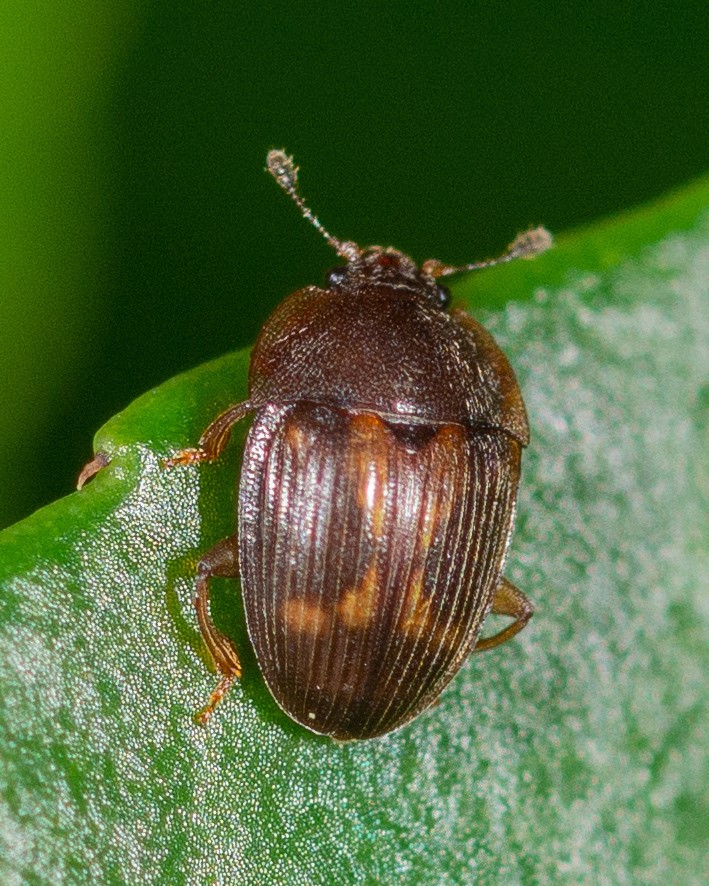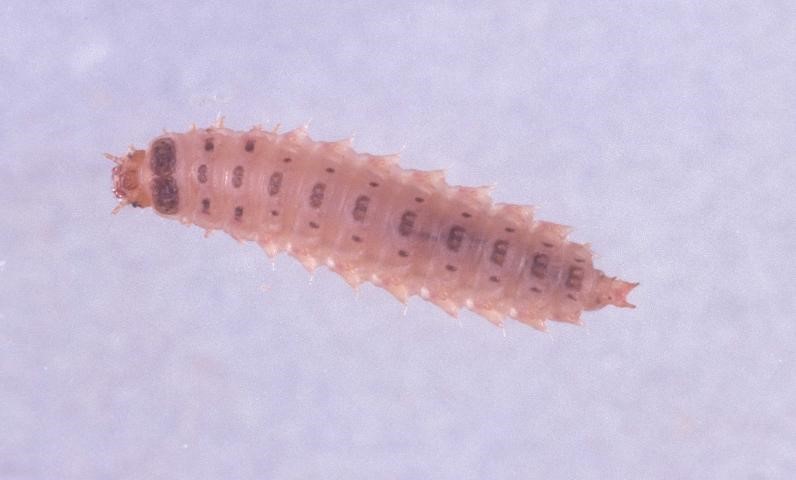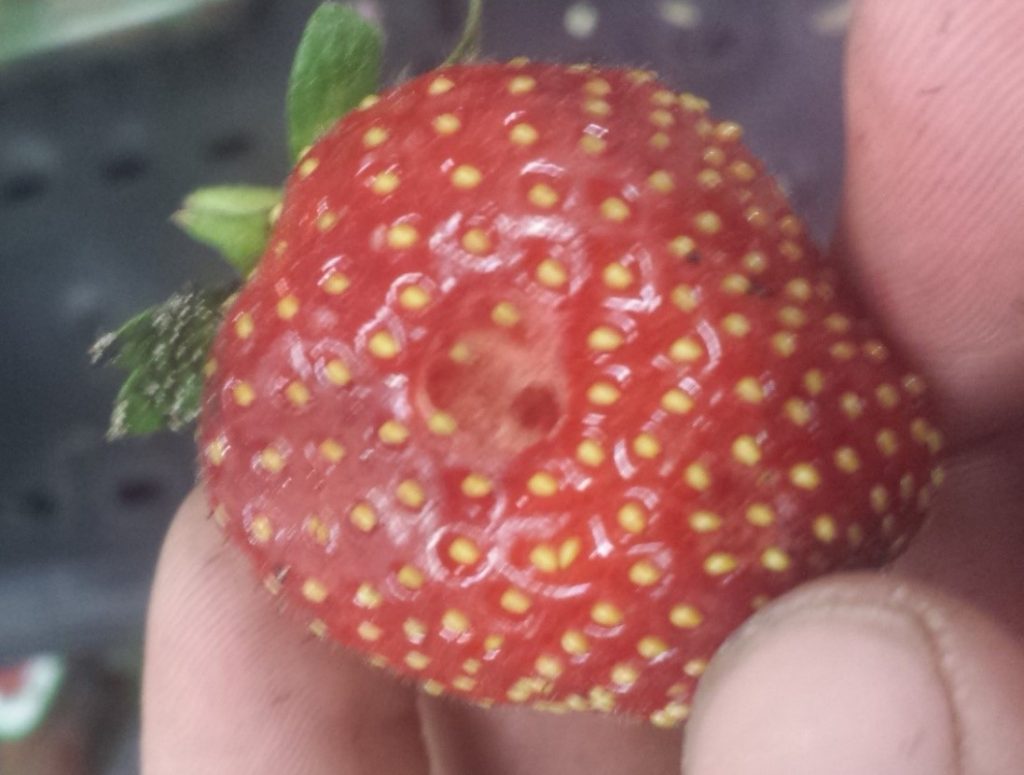Douglas G. Pfeiffer, Dept. of Entomology, Virginia Tech, Blacksburg VA, and Jayesh B. Samtani, Hampton Roads Agric. Res. and Ext. Center, Virginia Tech, Virginia Beach VA
Many people are familiar with sap or picnic beetles in the family Nitidulidae (Carpophilus sp.). Small black (about 6 mm), oval-shaped beetles with clubbed antennae and short elytra or front wings are sometimes seen in tips of corn ears that are previously damaged by other agents, e.g. corn earworm. Many species of sap beetles feed on overripe or rotting plant tissue. A less commonly seen species to most is the strawberry sap beetle, Stelidnota geminata (Say). This is one variety of sap beetles that may occur in strawberry plantings (Potter et al., 2013).
The adult strawberry sap beetle (Fig. 1) is about half the size of the picnic beetle in corn ears, about 3 mm. It is a dark mottled reddish brown, rather than the black appearance of Carpophilus spp. Its elytra are not truncated as in Carpophilus but extend to the end of the abdomen. The pronotum (the section of the thorax just behind the head and ahead of the wings) has edges that are flattened, giving a somewhat flared appearance. Larvae are slender grubs with a brown head capsule (Fig. 2). Both adults and larvae may cause injury of ripe and overripe strawberries (Fig 3).



Strawberry sap beetle overwinters in leaf litter in woods. While not typically overwintering in strawberry, it does overwinter in blueberry and raspberry plantings (Loughner et al. 2007b). Beetles fly into strawberry beds, sometimes from considerable distances (Loughner et al. 2007a). Strawberry sap beetle is most common in wooded settings early and late in the season, favoring agricultural settings during the summer (Blackmer and Phelan 1995).
Injury
Round deep holes are eaten into the sides of ripe and over-ripe strawberries. Fruit is more likely to be fed upon when in contact with the soil, relative to berries higher in the canopy (Rhainds and English-Loeb 2002). However, injury sometimes occurs in berries off the ground as well (Loughner et al. 2008).
Management
Cultural control
Berries should be harvested frequently when they are ripe and before becoming over-ripe. Infestations are more severe later in the harvest season when day-time temperatures are on rise and particularly following rain events. Infestations may be more severe in pick-your-own operations where customers leave fruit behind. Clean-up picking should follow the public picking operation. Baited traps are sometimes recommended for mass-trapping strawberry sap beetles. Baits can include various plant products that emit a fermenting or rotting odor. Whole wheat bread dough was used by Rhainds and English-Loeb (2002). Ripe strawberries can be an effective bait for sap beetles infesting strawberries (Fornari et al. 2013). One trapping study found that traps along the periphery resulted in higher sap beetles numbers in the planting (Rhainds and English-Loeb 2002), so if used, traps should be placed away from the bed. Baited fruits should be discarded off-site. Good management of rots and fungal diseases will lower the incidence of strawberry sap beetle injury, since the beetles are attracted to rotting fruit (Swett et al. 2020).
Chemical control
Since strawberry sap beetle attacks ripe fruit, preharvest intervals should be considered closely if chemical control is desired. Pyrethroid sprays have been effective against strawberry sap beetle. This class is disruptive by way of secondary pest outbreaks, in particular, spider mites. Rhainds and English-Loeb (2002) reported that fenpropathrin (Danitol; PHI = 3 days) effectively reduced sap beetle injury when applied at dusk or mid-day, between appearance of first ripe berries and first harvest. A more selective material, novaluron (Rimon, PHI -= 1 day), is recommended in our southeast regional publication (Melanson et al. 2022). Though beetles fly in from outside the strawberry bed, border sprays may not provide benefit (Loughner et al. 2008).
Biological control
Young larvae of strawberry sap beetle larvae (among other nitidulids) is controlled by the parasitoid Brachyserphus abruptus (Say) (Williams et al. 1992). Entomopathogenic nematodes that are potential sources of mortality of soil-dwelling stages of strawberry sap beetles were mentioned by Rondon et al. (2011). Natural enemies attacking strawberry sap beetle may be favored by wildflower strips near the bed (McCabe et al. 2017).
References
Blackmer, J. L., and P. L. Phelan. 1995. Ecological analyses of Nitidulidae: seasonal occurrence, host choice and habitat preference. J. Appl. Entomol. 119: 321-329.
Fornari, R. A., R. Machota, D. Bernardi, M. Botton, and P. L. Pastori. 2013. Evaluation of damage, food attractivts and population dynamics of strawberry sap beetle. Hortic. Bras. 31: 380-385.
Loughner, R. L., G. M. Loeb, and W. W. Turechek. 2007a Strawberry sap beetle (Coleoptera: Nitidulidae) distribution in New York and differential movement in two types of habitat. J. Entomol. Sci. 42: 603-609.
Loughner, R. L., G. M. Loeb, K. Demchak, and S. Schloemann. 2007b. Evaluation of strawberry sap beetle (Coleoptera: Nitidulidae) use of habitats surrounding strawberry plantings as food resources and overwintering sites. Environmental Entomol. 36: 1059–1065.
Loughner, R., G. M. Loeb, S. Schloemann, and K. Demchak. 2008. Evaluation of cultural practices for potential to control strawberry sap beetle (Coleoptera: Nitidulidae). J. Econ. Entomol. 101: 850-858.
McCabe, E., G. Loeb, and H. Grab. 2017. Responses of crop pests and natural enemies to wildflower borders depens on fnctional grop. Insects 8:(3): 1-8.
Melanson, R., G. Schnabel, P. Brannen, M. H. Ferguson, J. Desaeger, B. Cline, I. Tzanetakis, R. Singh, N. Gauthier, J. Samtani, K. Fontenot, A. Sial, F. Hale, D. Pfeiffer, A. Cato, M. Favre, D. Lockwood, M. T. Mengak, and K. Jennings. 2022. 2022 Southeast Regional Strawberry Integrated Pest Management Guide for Plasticulture Production. Univ. Ga. Extension Pub. 119-3. 74 p.
Potter, M. A., J. F. Price, D. H. Habeck, D. J. Schuster, and E. McCord. 2013. A survey of sap beetles (Coleoptera: Nitidulidae) in strawberry fields in West Central Florida. Fla. Entomol. 96: 1188-1189.
Rhainds, M., and G. English-Loeb. 2002. Impact of insecticide application and mass trapping on infestation by strawberry sap beetles (Coleoptera: Nitidulidae). J. Entomol. Sci. 37: 300-307.
Rondon, S. I., J. F. Price, D. J. Cantliffe, and J. M. Renkema. 2011. Sap beetle (Coleoptera: Nitidulidae) management in strawberries. Univ. Fla. Extension. HS991. 4 pp.
Swett, C. L., B. B. Butler, N. A. Peres, E. E. Koivunen, E. M. Hellman and J. R. Beaulieu. 2020. Using model-based fungicide programing to effectively control botrytis and anthracnose fruit rots in mid-Atlantic strweberry field and co-manage strawberry sap beelt (Stelidnota geminate [sic]). Crop Protect. 124: 105175,10 p.
Williams, R. N., D. S. Fickle, and J. R. Galford. 1992. Biological studies of Brachyserphus abruptus [Hym.: Proctotrupidae], a nitidulid parasite. Entomophaga. 37:91-98